The Ultimate Guide to Buying a Greenhouse in the UK
If you’re serious about gardening in the UK, a greenhouse isn’t just a luxury — it’s a game-changer. Whether you’re growing tender vegetables, protecting delicate plants from late frosts, or simply looking to extend your growing season, a greenhouse gives you the control and versatility that outdoor planting can’t match.
But with so many types, sizes, materials, and features available, choosing the right greenhouse can feel overwhelming — especially if it’s your first time buying one. That’s where this guide comes in.
At GardenFurnitureSets, we’ve helped thousands of UK gardeners find the perfect setup for their outdoor space. Drawing on years of experience and customer insight, this ultimate guide covers everything you need to know about buying a greenhouse in the UK — from frame materials and glazing options to size recommendations, placement tips, and even planning permission rules.
Whether you’re after a compact starter greenhouse for herbs and seedlings or a larger structure for year-round growing, we’ll help you make an informed decision that suits your garden, your goals, and your budget.
Let’s dig in.
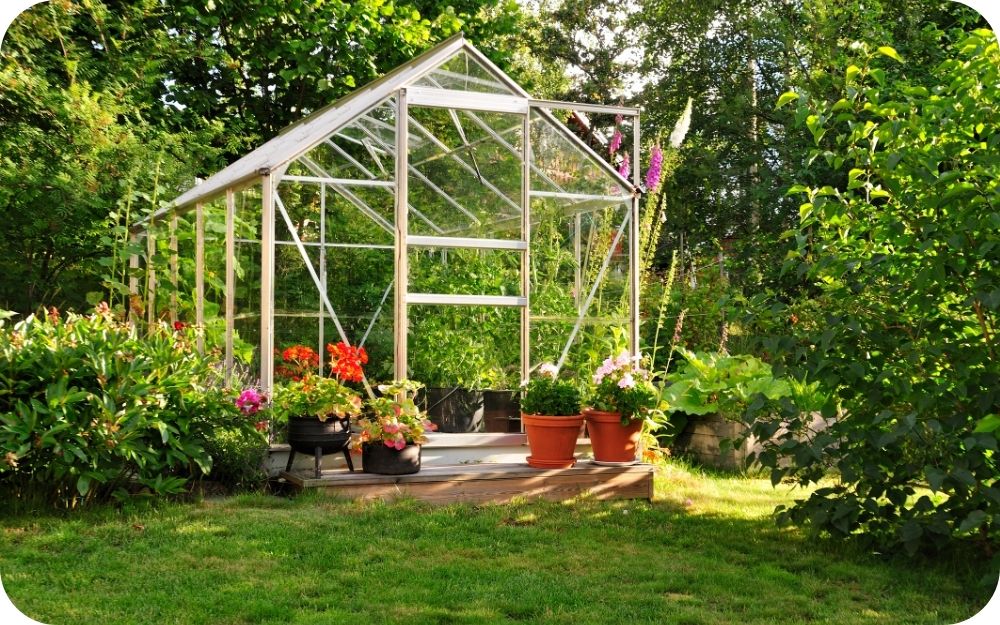
What Is a Greenhouse and Why Buy One?
A greenhouse is a garden structure designed to create a controlled environment for growing plants. Typically made from a metal or wooden frame with transparent glazing (such as glass or polycarbonate), greenhouses allow sunlight in while providing protection from wind, rain, frost, and pests. This creates a warmer, more stable microclimate ideal for cultivating a wide variety of plants all year round.
But why should you invest in one?
In the UK’s unpredictable climate, a greenhouse is a powerful tool for any gardener. It allows you to start sowing earlier in the year, extend the growing season into autumn and winter, and grow heat-loving crops like tomatoes, cucumbers, and chillies that might otherwise struggle outdoors. It also provides a safe haven for delicate plants and seedlings during cold snaps or unexpected downpours.
Whether you’re an experienced green thumb or just getting started, owning a greenhouse opens up a world of possibilities:
- 🌱 Grow your own vegetables, herbs, and flowers from seed
- 💰 Save money on supermarket produce and garden centre plants
- 🗓️ Enjoy gardening as a year-round hobby
- 🛡️ Protect your investment in plants and tools from the elements
From compact lean-tos for patios to spacious walk-in greenhouses for keen growers, there’s a model to suit every outdoor space and skill level.
Types of Greenhouses
Greenhouses come in a range of styles and configurations, each suited to different gardens, budgets, and levels of experience. Understanding the main types of greenhouses available in the UK will help you choose a structure that meets your needs and makes the most of your outdoor space.
1. Freestanding Greenhouses

Freestanding greenhouses are standalone structures that can be placed anywhere in the garden, provided there’s sufficient space and sunlight. They offer the most flexibility in terms of size, layout, and ventilation.
Best for:
– Serious gardeners or those with larger gardens
– Growing a wide variety of plants all year round
Pros:
✅ Excellent airflow and light distribution
✅ Often available in a wide range of sizes
✅ Can be positioned for maximum sun exposure
Cons:
❌ Requires more space than other types
❌ May need additional anchoring in exposed areas
2. Lean-to Greenhouses
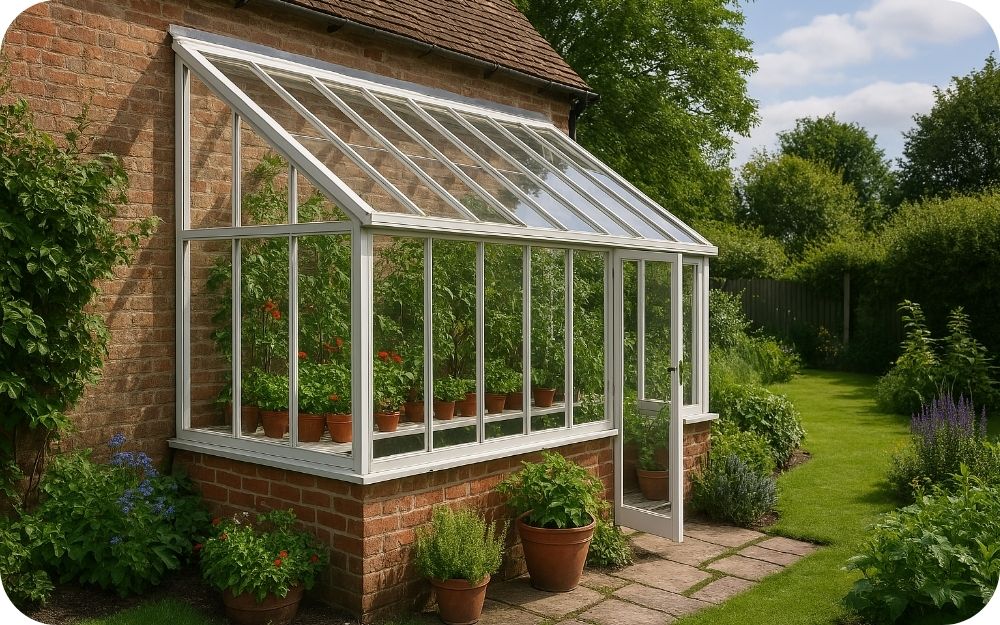
A lean-to greenhouse is designed to attach to the side of an existing structure, such as a house or garage. These are great space-saving options for smaller gardens or patios.
Best for:
– Urban gardeners or those with limited outdoor space
– Easy access to electricity and water (if attached to the home)
Pros:
✅ Makes use of an existing wall for warmth and stability
✅ Easy to access from the house
✅ Compact and space-efficient
Cons:
❌ Limited in size and layout options
❌ Must be positioned against a suitable wall with good sunlight
3. Mini Greenhouses
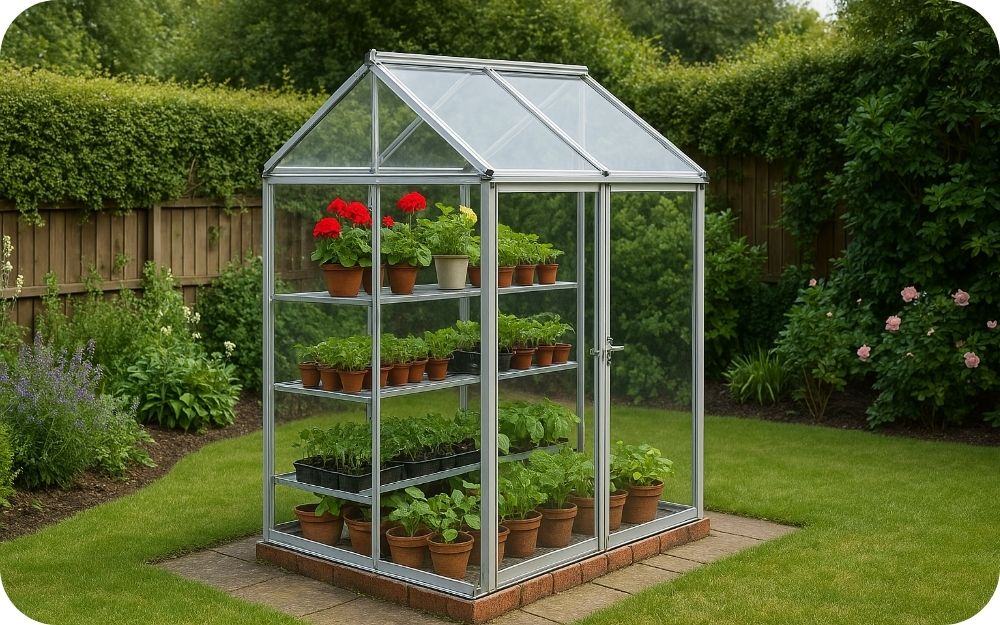
Mini greenhouses, also called cold frames or compact greenhouses, are smaller structures designed for balconies, courtyards, or beginners who don’t need a full-size setup.
Best for:
– Seedlings, herbs, or single-season growing
– Beginners or those with very limited space
Pros:
✅ Affordable and easy to move
✅ Great for starting plants before transferring outdoors
✅ Ideal for patios and balconies
Cons:
❌ Limited growing space
❌ Less protection and insulation compared to full-sized models
4. Cold Frames
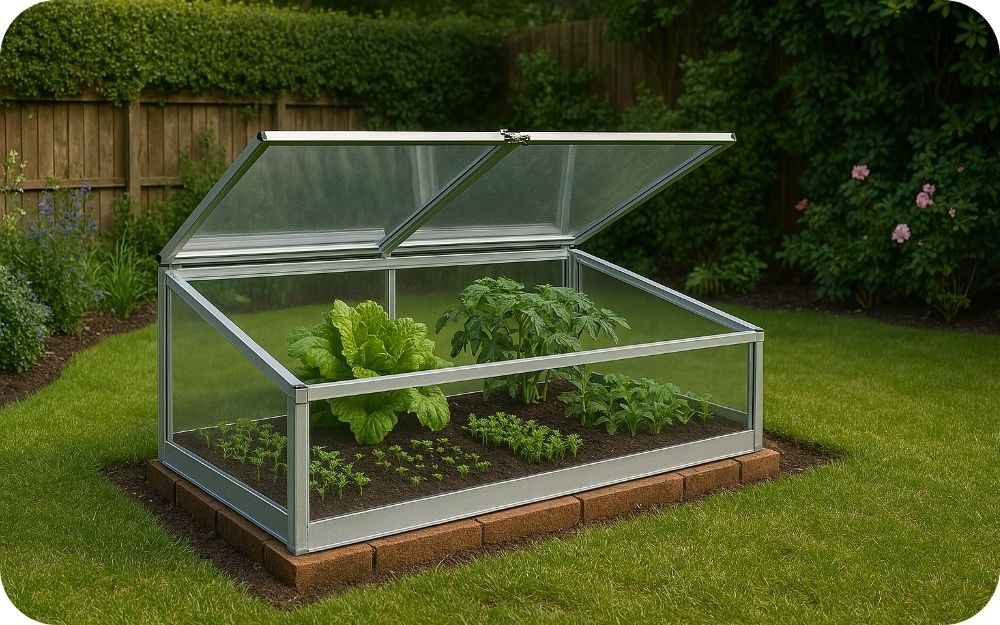
Cold frames are low, box-like structures with a transparent lid. They’re a simple and affordable way to protect young plants and harden off seedlings.
Best for:
– Hardening off plants before transplanting
– Extending the growing season in spring and autumn
Pros:
✅ Inexpensive and easy to use
✅ Helps protect seedlings and young plants
✅ Great addition to larger greenhouses
Cons:
❌ Not suitable for taller plants or full-season growing
❌ Manual ventilation may be needed
Each type of greenhouse has its place — the best choice depends on your garden layout, growing ambitions, and budget. In the next section, we’ll look at one of the most important decisions when buying a greenhouse: frame materials.
Greenhouse Frame Materials
When buying a greenhouse, the frame material plays a crucial role in determining its strength, appearance, maintenance needs, and overall lifespan. In the UK, the most common greenhouse frame materials are aluminium, wood, and steel — each with its own strengths and ideal use cases.
1. Aluminium Greenhouse Frames
Aluminium is the go-to option for many UK gardeners. It’s lightweight, strong, and virtually maintenance-free, making it perfect for a wide range of gardens.
Pros:
✅ Corrosion-resistant and weatherproof
✅ Lightweight and easy to install
✅ Low maintenance – no painting or treatments required
✅ Often more affordable than wooden options
✅ Sleek, modern look
Cons:
❌ Lacks the traditional charm of timber
❌ May require extra bracing in very exposed areas
Best for:
– Low-maintenance gardening
– Urban gardens or patios
– Long-term durability with minimal upkeep
2. Wooden Greenhouse Frames
Wooden frames offer timeless charm and natural beauty. Often made from cedar or treated softwood, they blend seamlessly into traditional or cottage-style gardens.
Pros:
✅ Attractive, natural appearance
✅ Excellent insulation properties
✅ Strong and sturdy feel
Cons:
❌ Requires regular maintenance (painting or staining)
❌ Typically more expensive than aluminium or steel
❌ Heavier and more labour-intensive to assemble
Best for:
– Traditional or decorative garden settings
– Gardeners who don’t mind seasonal upkeep
– Adding a focal feature to your outdoor space
3. Steel-Framed Greenhouses
Steel-framed greenhouses are an increasingly popular option, particularly in the portable or pop-up greenhouse category. These often come with UV-resistant PE covers, making them ideal for seasonal growing or small garden spaces.
Pros:
✅ Strong and stable frame
✅ Often more affordable than other options
✅ Quick to set up and take down
✅ Lightweight and portable
✅ Great for temporary or seasonal use
Cons:
❌ Covers may need replacing over time
❌ Not designed for heavy snow loads or high winds without anchoring
❌ Less insulation than glass or polycarbonate
Best for:
– New or casual gardeners
– Allotments, patios, and small gardens
– Seasonal growing and seed starting
Tip: If you’re looking for a low-commitment, cost-effective way to get started with greenhouse gardening, a steel-framed model with a PE cover is a fantastic entry point.
Glazing Options: Glass, Polycarbonate or PE Cover?
Choosing the right glazing for your greenhouse is just as important as picking the right frame. The material you choose affects how much light your plants receive, how well heat is retained, how safe the structure is, and how long it lasts — all key considerations for gardening in the UK.
Let’s explore the most common greenhouse glazing options and what makes each one unique.
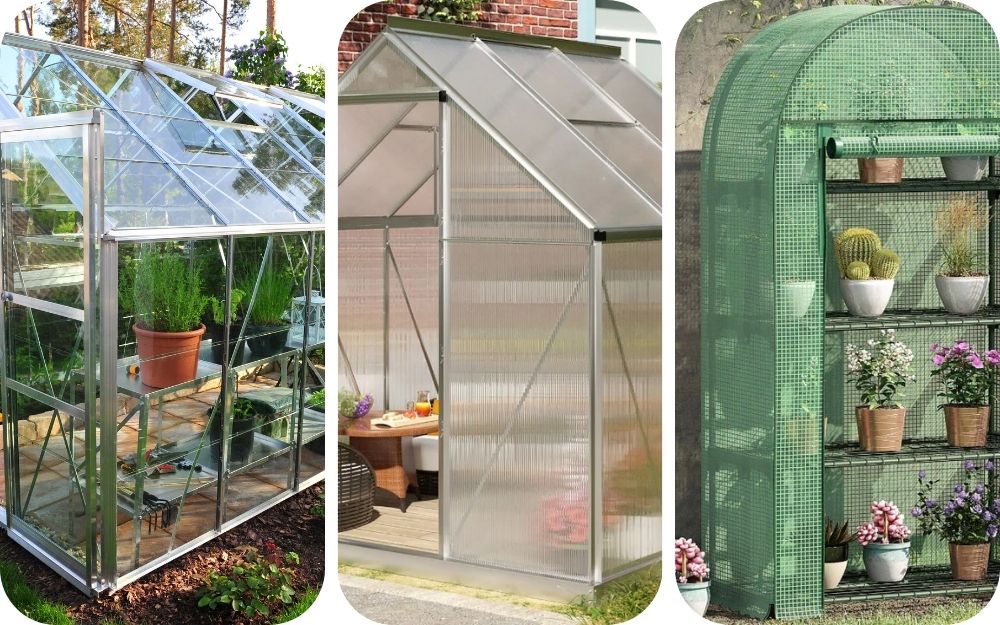
Horticultural Glass
This is the traditional choice you’ll find in many classic-style greenhouses. It’s cost-effective and allows excellent light transmission, making it ideal for encouraging strong plant growth, especially in spring and summer.
However, it does have its limitations. Horticultural glass is more fragile than other materials and can shatter into sharp pieces if broken — something to consider if you have children or pets in the garden. It also provides very little insulation, meaning it’s not the best performer in colder months.
Still, for gardeners after a timeless look and excellent visibility on a budget, it remains a popular option.
Toughened Safety Glass
If you like the appearance of glass but want something stronger and safer, toughened glass is a great upgrade. It’s heat-strengthened during manufacturing, making it much more durable and better suited to exposed or windy locations.
Importantly, if it does break (which is rare), it crumbles into small, blunt pieces rather than sharp shards — making it a smart choice for family gardens or public spaces. It’s heavier and a little more expensive than standard glass, but many gardeners consider that a worthwhile trade-off for added peace of mind and performance.
Polycarbonate Panels
Polycarbonate is a popular choice for modern greenhouses — and for good reason. Twin-wall panels offer excellent insulation by trapping air between the layers, helping to maintain a more stable temperature inside your greenhouse. This makes it ideal for growing all year round, particularly during the unpredictable British winter.
Unlike glass, polycarbonate won’t shatter and is lightweight and easy to handle, making it great for DIY installations. The light it lets in is slightly diffused, which can actually benefit plant growth by preventing scorching on hot days.
It’s not as crystal clear as glass and can become cloudy over time if not UV-treated, but for many gardeners, the balance of safety, insulation, and durability makes it a solid all-rounder.
UV-Resistant PE Covers
You’ll typically find these on steel-framed or portable greenhouses. The covers are made from polyethylene (PE) and treated to resist UV damage, helping them withstand the sun’s rays and last longer than basic plastic sheeting.
While PE covers don’t provide the same level of insulation as glass or polycarbonate, they’re perfect for seasonal use — like starting seeds in spring or growing crops through the warmer months. They’re lightweight, budget-friendly, and easy to move or store when not in use, making them especially popular on patios, balconies, and allotments.
This style of glazing might not be a long-term solution for serious year-round growers, but as a low-commitment way to get started with greenhouse gardening, it’s hard to beat.
In short:
- Want a traditional look on a budget? Go for horticultural glass.
- Need strength and safety in exposed gardens? Toughened glass is worth the investment.
- Looking for year-round insulation and a family-safe option? Polycarbonate ticks the boxes.
- Starting out or need a flexible, seasonal setup? Try a PE-covered steel-framed greenhouse.
Choosing the Right Size
When it comes to greenhouses, size matters — but not always in the way you might think. The right size greenhouse for you depends on your available space, what you plan to grow, and how much time and effort you want to put into maintaining it.
Think Long-Term
One of the most common pieces of advice from experienced gardeners is this: go as big as your space and budget will allow. Why? Because most people quickly outgrow their first greenhouse. What starts as a small space for a few tomato plants soon becomes crowded with trays of seedlings, pots, tools, and growing ambitions.
Even if you're just starting out, having extra room gives you flexibility — whether that’s for staging and shelving, overwintering tender plants, or experimenting with new crops down the line.
Measure Your Space — and Then Double Check
Before buying, measure your garden, patio, or allotment carefully. Don’t just look at length and width — consider height as well, especially if you plan to grow tall crops like tomatoes, cucumbers, or even citrus trees. You’ll also want enough headroom to stand and move around comfortably.
Make sure there’s easy access around the greenhouse for cleaning, maintenance, and ventilation. If it's going against a wall or fence (especially for lean-tos), check for overhangs, guttering, and window obstructions.
Small, Medium or Large? Here’s a Quick Guide:
- Small Greenhouses (up to 6x4ft):
Ideal for beginners, courtyards, or those with limited space. Great for herbs, small veg, and getting a feel for greenhouse gardening. - Medium Greenhouses (6x6ft to 8x6ft):
Offers a good balance of growing space and accessibility. Perfect for most hobby gardeners, especially those growing a mix of crops and seedlings. - Large Greenhouses (10ft+):
Best for serious growers or those looking to garden all year round. These are great for installing permanent staging, water butts, automatic vents, and even walkways.
Don’t Forget Storage and Staging
Remember — not every inch of your greenhouse will be used for growing. You’ll want space for potting benches, trays, shelves, and even tool storage. Overcrowding leads to poor airflow, which can encourage pests and disease.
Planning for Growth
Even if you're a beginner now, it's worth thinking about where your gardening journey might take you. Many greenhouse owners start small and end up wishing they’d bought a larger model in the first place. If you’re choosing between two sizes and both will fit your space — go bigger. You won’t regret the extra room.
Where to Position Your Greenhouse for the Best Results
Even the best greenhouse won’t perform well if it’s in the wrong spot. Proper positioning is essential for making the most of natural light, maintaining a stable temperature, and protecting your structure from the elements.
Here's what to consider when choosing the ideal location for your greenhouse in the UK.
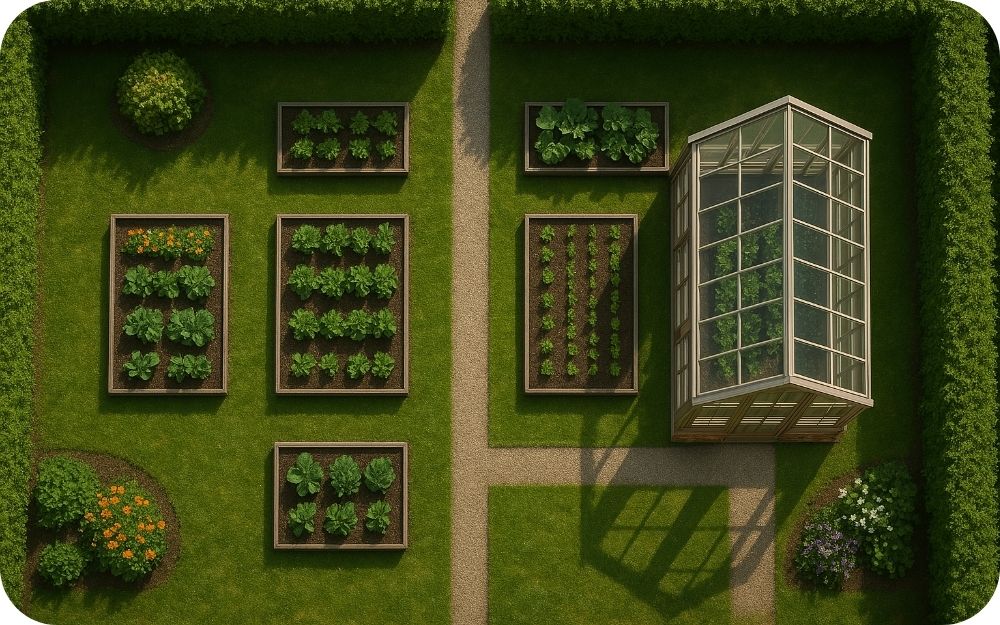
Maximise Sunlight
The most important rule? Sunlight is everything. Aim to place your greenhouse in a spot that gets as much direct sunlight as possible — ideally from morning through to late afternoon. In the UK, the best orientation is generally east to west, which maximises light exposure throughout the day, especially during the cooler spring and autumn months.
If your garden is shaded by trees, fences, or buildings, try to choose the clearest, sunniest spot available. Even partial shading can reduce temperatures and slow down plant growth.
Consider Shelter from Wind
While light is crucial, wind exposure is another big factor. Strong gusts can make it harder to maintain internal temperatures and may even damage lightweight greenhouses, particularly those with PE covers or less anchoring.
Where possible, position your greenhouse with natural windbreaks — such as hedges, fences, or walls — nearby. Just be careful not to block too much sunlight in the process.
If your site is particularly exposed, you might want to anchor the greenhouse more securely or choose a model with additional bracing.
Level Ground Is a Must
Your greenhouse will need a solid, level base — not just for stability, but also to ensure doors open properly and rainwater drains away correctly. A flat, even surface will also make it easier to install internal shelving and equipment.
Common base options include:
- Paving slabs
- Concrete
- Timber frames
- Gravel with treated timbers
Some greenhouses can also be installed directly onto grass or soil with appropriate anchoring, but this can affect longevity and drainage.
Access to Water and Electricity
It’s easy to overlook, but access to water — and, if possible, electricity — can make your greenhouse setup much more convenient. Having a hose nearby or a water butt connected to your greenhouse gutters will save you endless back-and-forth trips with a watering can. And if you're planning to use heaters, lights, or automatic vents, proximity to an outdoor power source is a big bonus.
Don’t Forget Practical Access
Make sure you have a clear and easy path to your greenhouse, especially if you’ll be using it in winter or during wet weather. Stepping stones, gravel, or paving can prevent muddy shoes and make trips back and forth more pleasant.
Quick Checklist:
- ✅ Full sun, ideally east–west orientation
- ✅ Sheltered from strong winds
- ✅ Level ground with proper drainage
- ✅ Close to water and (ideally) electricity
- ✅ Easy, year-round access
Ventilation and Temperature Control
Maintaining the right environment inside your greenhouse is just as important as choosing the right model. Without proper ventilation and temperature control, even the best-built greenhouse can become a breeding ground for pests, mould, and overheating — especially during the UK’s increasingly unpredictable summers.
Let’s look at how to regulate your greenhouse climate effectively, so your plants can thrive all year round.
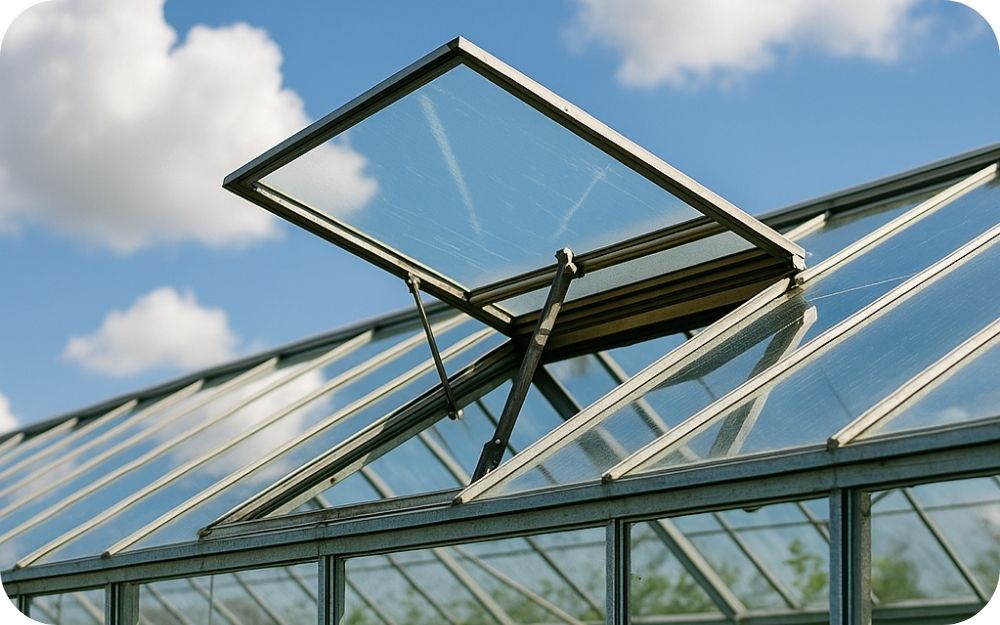
Why Ventilation Matters
Good ventilation helps regulate temperature, control humidity, and promote healthy airflow — all of which are crucial for preventing disease and encouraging strong plant growth. Stale, stagnant air can lead to fungal issues like botrytis (grey mould) or encourage infestations of pests such as aphids and red spider mites.
In short, ventilation isn’t optional — it’s essential.
Built-In Vents: Roof and Side
Most quality greenhouses include roof vents — and ideally side louvre vents too. These allow hot air to escape from the top and cool air to enter from the sides, creating a natural flow.
If your greenhouse comes with just one vent, consider upgrading or adding another. Two or more vents will allow better cross-ventilation, especially in larger greenhouses.
For best results:
- Keep vents open during warm days
- Use side vents or leave doors ajar for extra airflow
- Close up in the evening to retain heat
Automatic Vent Openers
Worried about forgetting to open or close your vents? Automatic vent openers are a simple and brilliant solution. These clever devices use temperature-sensitive mechanisms (often wax-filled pistons) to open and close vents as needed — no electricity required.
They're ideal for busy gardeners or anyone who’s away during the day and wants peace of mind that their plants aren’t baking in the sun.
Shading Solutions
While light is essential, too much direct sunlight in summer can cause scorching and overheating. Consider:
- Internal shading (blinds or netting)
- External shading paint (temporary and easy to apply)
- Positioning tall plants or staging to create natural shade
Shading helps moderate internal temperatures and can also reduce water loss through evaporation.
Heating for Winter
To keep growing through the colder months, some gardeners opt for greenhouse heaters — either electric, paraffin, or solar-powered. Electric fan heaters are reliable and provide even heat distribution, but they do require a power source.
For frost protection, a simple propagator or tube heater may be all you need, particularly in smaller greenhouses or when protecting young plants.
If you're growing all year round, insulating the greenhouse with bubble wrap around the glazing can also help retain heat and reduce energy use.
Monitoring Your Greenhouse Climate
To get the best results, it’s worth investing in a minimum/maximum thermometer or digital climate monitor. This helps you understand temperature swings and make informed decisions about ventilation, shading, and heating.
Summary Tips:
- Open vents daily (or install automatic openers)
- Use shading in summer to prevent scorching
- Add heat or insulation in winter if growing year-round
- Monitor temperature and humidity regularly
Essential Greenhouse Accessories
Once your greenhouse is up and running, the right accessories can make a huge difference to how efficient, productive, and enjoyable your growing experience becomes. From simple staging to clever automation, here are the essential greenhouse accessories every UK gardener should consider.
Greenhouse Staging and Shelving
Staging (essentially bench-style shelving) allows you to make the most of your greenhouse’s vertical space. It’s perfect for seed trays, pots, and small tools — and it keeps everything organised and off the floor.
Freestanding staging is easy to move and customise, while fixed shelves maximise space in compact greenhouses. Look for slatted designs to improve air circulation and drainage.
Vent Openers and Thermometers
If you haven’t already installed automatic vent openers, they’re well worth the upgrade. Pair them with a minimum/maximum thermometer so you can track the highest and lowest internal temperatures throughout the day.
This simple combo gives you greater control over your growing conditions — especially during the changeable British spring and autumn seasons.
Watering Solutions
Watering by hand is fine for small greenhouses, but if you’re growing a lot — or want to avoid daily watering in summer — you might want to consider:
- Capillary matting: absorbs water and feeds pots from below
- Drip irrigation systems: consistent and efficient
- Water butts: collect rainwater from greenhouse gutters for eco-friendly use
A watering can will always have its place, but a bit of automation can save time and improve consistency.
Plant Supports and Ties
Many greenhouse crops — especially tomatoes, cucumbers, and chillies — need support as they grow. Add string lines, cane supports, or mesh netting to help keep tall or vining plants upright and healthy. Hooks or eyelets built into the frame can be handy for tying plants in securely.
Heating and Insulation
If you're planning to grow through winter or protect delicate plants from frost, a small greenhouse heater can be a game-changer. Even a low-wattage tubular heater can make a difference in maintaining a frost-free environment.
Add bubble wrap insulation to your glazing during the colder months to help retain heat and reduce energy use — it’s inexpensive and easy to install.
Handy Extras
- 🌱 Seed trays and propagators for germinating early crops
- 🪴 Potting bench for a dedicated workspace
- 💡 Grow lights if natural light is limited
- 🪰 Pest control (sticky traps or biological controls) to keep things in check
You don’t need to buy everything at once — part of the fun of greenhouse gardening is expanding and tweaking your setup as your experience grows. But starting with the right basics will give your plants the best chance of thriving from day one.
Maintenance and Longevity
A greenhouse is an investment — not just in your garden, but in your lifestyle. With the right care and attention, a well-built greenhouse can last for many years, even decades. But longevity doesn’t just depend on what you buy — it also depends on how you maintain it.
Here’s how to keep your greenhouse in top condition and ensure it continues to serve you season after season.
Regular Cleaning
Dirt, algae, and grime can quickly build up on greenhouse glazing, reducing light levels and encouraging pests or disease. Make it a habit to:
- Clean the glass or panels with warm soapy water at least once or twice a year — ideally in spring and autumn.
- Clear out old plant matter, dead leaves, and unused pots to avoid attracting mould or pests.
- Disinfect staging, tools, and seed trays before reusing them.
This not only keeps things tidy, it also ensures your plants get the maximum light they need to grow strong and healthy.
Check for Wear and Tear
Over time, seals, bolts, and fasteners can loosen or degrade — particularly in exposed areas. At least once a year, give your greenhouse a quick inspection:
- Tighten any loose nuts and bolts
- Check for cracked glazing or broken panels
- Replace worn or damaged seals to keep it airtight
- Ensure vents and doors open and close smoothly
Catch small issues early, and you’ll prevent them turning into bigger problems down the line.
Seasonal Jobs
- 🌸 Spring: Clean thoroughly, inspect for damage, and prepare for the busiest growing season
- ☀️ Summer: Monitor ventilation and shading closely to avoid overheating
- 🍂 Autumn: Clear out spent crops, tidy up, and disinfect surfaces
- ❄️ Winter: Insulate (if needed), secure structure against storms, and reduce moisture build-up
Following this rhythm keeps your greenhouse working efficiently and helps extend the life of both the structure and everything you grow inside it.
Frame-Specific Maintenance
Aluminium frames are virtually maintenance-free but may benefit from an occasional wipe-down and bolt check.
Wooden frames require a bit more TLC. Treat the wood annually with a preservative or paint to protect against rot and damp. Keep an eye on joints, hinges, and areas where moisture might build up.
Steel-framed greenhouses with PE covers are low-maintenance, but the covers may need replacing every few years depending on exposure and weather. Store them indoors during winter to prolong their lifespan.
Longevity at a Glance
- A well-maintained aluminium greenhouse can last 20+ years
- Wooden greenhouses, with proper care, often last 10–15 years or more
- Steel-framed greenhouses with PE covers typically last 3–5 years, but replacement covers are affordable and easy to fit
Taking time for a little maintenance each season goes a long way toward protecting your investment — and ensuring your greenhouse remains a productive, enjoyable part of your garden for years to come.
Planning Permission: Do You Need It?
One of the most common questions people ask when buying a greenhouse is whether they need planning permission — and the good news is, in most cases, you don’t.
Greenhouses are generally considered permitted development in the UK, which means they can be installed without formal planning permission, as long as they meet certain conditions.
Here’s what you need to know.
General Rules (England and Wales)
Your greenhouse is likely to be classed as a “garden outbuilding,” which means you can install one without planning permission if:
- It’s for domestic use only (not for business or living accommodation)
- The structure is single-storey
- It takes up less than 50% of your garden space
- It’s no taller than 2.5m if within 2 metres of a boundary
- It’s no taller than 3m (or 4m if it has a dual-pitched roof) if further from the boundary
- It’s not placed forward of the front wall of your house
If your greenhouse ticks all these boxes, you’re good to go.
Exceptions to Watch Out For
There are some cases where planning permission might still be required:
- You live in a listed building or conservation area
- Your property has had permitted development rights removed (common in new-build estates)
- You’re installing a very large or tall greenhouse
- You’re planning to run a business or grow commercially
If any of these apply, it’s best to check with your local planning authority before placing your order.
What About Allotments?
If you’re putting up a greenhouse on an allotment, you’ll likely need permission from the council or site manager. Many allotments have specific size or material guidelines for structures — check before building.
Need Help?
If you’re unsure whether your planned greenhouse meets permitted development rules, it’s always worth contacting your local council for advice. A quick phone call can save you time, money, and hassle down the line.
Final Thoughts
A greenhouse is more than just a structure — it’s a gateway to a more rewarding, productive, and enjoyable gardening experience. Whether you're growing your own food, starting plants from seed, or simply looking for a peaceful retreat surrounded by greenery, the right greenhouse can transform your outdoor space and extend your growing season by months.
From choosing between glass, polycarbonate, or PE covers, to deciding on size, frame material, and where to place it, there’s a lot to consider. But with the guidance in this ultimate buyer’s guide, you’re now well-equipped to make an informed decision that suits your garden, your lifestyle, and your long-term goals.
At GardenFurnitureSets, we stock a wide range of greenhouses to suit all spaces and budgets — from compact steel-framed models for beginners, to larger wooden or aluminium greenhouses for year-round growers. With free UK delivery, excellent customer service, and a hand-picked selection of quality products, we’re here to help you get growing.
Ready to start your greenhouse journey?
👉 Browse our full range of greenhouses
👉 Got questions? Our friendly team is always happy to help. Call us on 01234 834693




